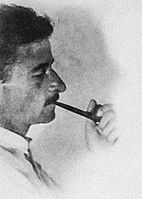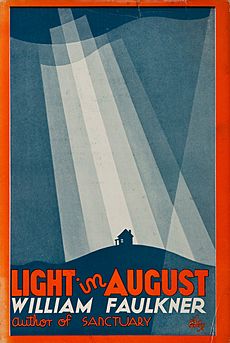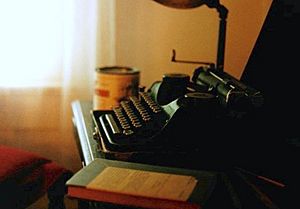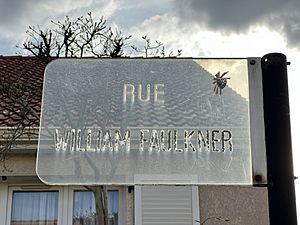William Faulkner facts for kids
Quick facts for kids
William Faulkner
|
|
|---|---|
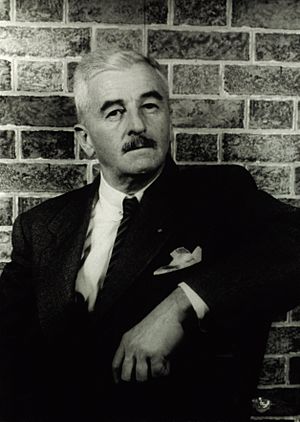
Faulkner in 1954, photographed by Carl Van Vechten
|
|
| Born | William Cuthbert Falkner September 25, 1897 New Albany, Mississippi, U.S. |
| Died | July 6, 1962 (aged 64) Byhalia, Mississippi, U.S. |
| Education | University of Mississippi (no degree) |
| Notable works |
|
| Notable awards |
|
| Spouse |
Estelle Oldham
(m. 1929) |
| Signature | |
William Cuthbert Faulkner (born September 25, 1897 – died July 6, 1962) was an American writer. He is famous for his novels and short stories. Many of his works are set in a made-up place called Yoknapatawpha County. This county was based on Lafayette County, Mississippi, where Faulkner lived most of his life.
Faulkner won the Nobel Prize in Literature. He is seen as one of the most important writers in American literature. Many also consider him the greatest writer from the Southern United States.
He was born in New Albany, Mississippi. His family later moved to Oxford, Mississippi. When World War I started, he joined the Royal Canadian Air Force. However, he did not fight in the war. He went back to Oxford and studied at the University of Mississippi. He left college after three semesters.
Faulkner moved to New Orleans and wrote his first novel, Soldiers' Pay (1925). He returned to Oxford and wrote Sartoris (1927). This was his first book set in his fictional Yoknapatawpha County. In 1929, he published The Sound and the Fury. The next year, he wrote As I Lay Dying. He also wrote Light in August, Absalom, Absalom!, and The Wild Palms. Faulkner also worked as a screenwriter in Hollywood. He helped write movies like To Have and Have Not and The Big Sleep.
Faulkner became very famous after his book The Portable Faulkner was published. He won the 1949 Nobel Prize in Literature for his "powerful and unique contribution to the modern American novel." He is the only Nobel Prize winner born in Mississippi. Two of his books, A Fable (1954) and The Reivers (1962), won the Pulitzer Prize for Fiction. Faulkner died on July 6, 1962, from a heart attack. This happened after he fell from his horse the month before.
Contents
William Faulkner's Life Story
Growing Up in Mississippi
William Cuthbert Falkner was born on September 25, 1897. He was the first of four sons. His parents were Murry Cuthbert Falkner and Maud Butler. His family was well-off, but not part of the very rich "cotton aristocracy." In 1902, his family moved to Oxford, Mississippi. His father opened a stable and hardware store. Later, his father became the business manager for the University of Mississippi. Faulkner lived in Oxford for most of his life.
As a boy, Faulkner loved listening to stories. His elders told him about the American Civil War, slavery, and the Ku Klux Klan. He also heard many stories about his own family. These stories deeply influenced him. They shaped his humor and his understanding of people in the South. He learned about both Black and White Americans. His characters often seemed simple but were very smart.
He was especially influenced by his great-grandfather, William Clark Falkner. This man was a legendary figure in North Mississippi. He grew up poor but became a strict Confederate colonel. He was also a member of the Mississippi House of Representatives. He even owned part of a railroad before he was murdered. Faulkner used many parts of his great-grandfather's life in his books.
Faulkner did well in school at first. He even skipped the second grade. But around fourth or fifth grade, he became quieter. He started skipping school and didn't care much about his homework. Instead, he became very interested in the history of Mississippi. His grades got worse, and he repeated the eleventh and twelfth grades. He never finished high school.
As a teenager, Faulkner dated Estelle Oldham. She was a popular girl from a well-known family. He hoped to marry her. But in 1918, another man, Cornell Franklin, proposed to Estelle before Faulkner did, and she accepted.
Starting His Writing Journey
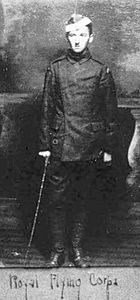
When Faulkner was 17, he met Phil Stone. Stone was four years older and loved literature. He had degrees from Yale University and the University of Mississippi. Stone read some of Faulkner's early poems and was very impressed. He was one of the first people to see Faulkner's talent and encourage him. Stone helped Faulkner by introducing him to writers like James Joyce. Joyce's style later influenced Faulkner's own writing. Faulkner gave his poems and short stories to Stone to send to publishers. But they were all turned down.
In 1918, Faulkner tried to join the US Army. He was rejected because he was too short and underweight. He then joined the Royal Canadian Air Force (Canadian RAF). He used a fake letter of recommendation. He went to Toronto for training. Despite what he claimed, records show he never flew or saw active service in World War I. He returned to Oxford in December 1918. He sometimes told fake war stories and even pretended to have a war wound.
Around 1918, Faulkner's last name changed from "Falkner" to "Faulkner." One story says a typesetter made a mistake on his first book. When asked if he wanted to fix it, he supposedly said, "Either way suits me." As a teenager, Faulkner mostly wrote poetry. He didn't write his first novel until 1925. He said his early writing was inspired by the Romantic era in England.
He enrolled at the University of Mississippi in 1919. He studied for three semesters but dropped out in November 1920. He joined a fraternity, Sigma Alpha Epsilon. He often skipped classes and got a "D" in English. However, some of his poems were published in campus magazines. In 1922, his poem "Portrait" appeared in a New Orleans magazine. Three years later, the magazine published his "New Orleans" short stories.
After leaving college, he took many different jobs. He worked at a bookstore in New York City. He was a carpenter in Oxford. He also worked as the postmaster at the University of Mississippi. He quit the post office saying, "I will be damned if I propose to be at the beck and call of every itinerant scoundrel who has two cents to invest in a postage stamp."
New Orleans and First Novels
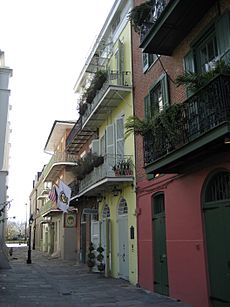
Many writers of Faulkner's time traveled to Europe. But Faulkner stayed in the United States. He spent the first half of 1925 in New Orleans, Louisiana. Many artists and writers lived there, especially in the French Quarter. Faulkner moved there in March. During this time, he started focusing more on stories than poems. His writing style changed from older Victorian styles to more modern ones. The Times-Picayune newspaper published some of his short stories.
Inspired by writer Sherwood Anderson, Faulkner wrote his first novel, Soldiers' Pay, in New Orleans. This book and his other early works were similar to those by Ernest Hemingway and F. Scott Fitzgerald. Anderson helped him get Soldiers' Pay and Mosquitoes published.
The small house at 624 Pirate's Alley in New Orleans is now a bookstore. It is also the home of the Pirate's Alley Faulkner Society.
In the summer of 1927, Faulkner wrote his first novel set in Yoknapatawpha County. It was called Flags in the Dust. This book used many traditions and much history from the South. Faulkner was very proud of it. He thought it was much better than his first two novels. But when he sent it to a publisher, it was rejected. Faulkner was very upset. He eventually let his agent, Ben Wasson, edit the book. It was published in 1929 as Sartoris. This book was important because it was his first to focus on the Civil War. His earlier books were about World War I.
The Sound and the Fury and Later Works
In autumn 1928, after his 31st birthday, Faulkner started The Sound and the Fury. He first wrote three short stories about the Compson children. But he soon felt these characters needed a full novel. He was still disappointed about Flags in the Dust being rejected. So, he wrote this new novel in a very experimental way. He later said, "One day I seemed to shut the door between me and all publisher's addresses and book lists. I said to myself, 'Now I can write.'" After finishing it, Faulkner insisted that no one edit it or add punctuation for clarity.
In 1929, Faulkner married Estelle Oldham. Estelle had two children from her first marriage. Faulkner hoped to support his new family by writing. Faulkner and Estelle had a daughter, Jill, in 1933. He started writing As I Lay Dying in 1929. He was working night shifts at the University of Mississippi Power House at the time. The novel was published in 1930.
Starting in 1930, Faulkner sent short stories to national magazines. Several were published. This earned him enough money to buy a house in Oxford for his family. He named it Rowan Oak. To make more money, Faulkner wrote Sanctuary. He also published short stories in magazines like The Saturday Evening Post.
Hollywood and More Novels
By 1932, Faulkner needed money. He tried to sell the rights to his new novel, Light in August, to a magazine for $5,000. But no one bought it. Then MGM Studios offered him a job as a screenwriter in Hollywood. Faulkner didn't go to movies much and wasn't sure about working in the film industry. But he really needed money. So, he went to Hollywood. He worked on about 50 films between 1932 and 1954. This job gave him a steady income to support his family.
He first wanted to work on Mickey Mouse cartoons. He didn't know they were made by Walt Disney Productions, not MGM. His first screenplay was for Today We Live. This movie was based on his short story "Turnabout." He also wrote a screenplay for Sartoris, but it was never made into a movie. In 1944, Faulkner wrote a screenplay for Ernest Hemingway's novel To Have and Have Not. This film was the first to star Lauren Bacall and Humphrey Bogart. Bogart and Bacall also starred in The Big Sleep, another film Faulkner worked on.
Faulkner didn't like Hollywood much. He wrote letters complaining about it. He felt like a writer trapped in a strange place. Many scholars say this made him very unhappy. In Hollywood, he became friends with director Howard Hawks. They both enjoyed hunting. Howard Hawks' brother, William Hawks, became Faulkner's Hollywood agent. Faulkner continued to find steady work as a screenwriter.
During World War II, in 1942, Faulkner tried to join the United States Air Force. He was rejected. Instead, he worked in local civil defense. The war made Faulkner lose his writing energy. He said the war was "bad for writing." In 1943, he started a new novel. It combined the idea of the Unknown Soldier from World War I with the story of Jesus. This book, A Fable, was published over ten years later. It won the 1954 Pulitzer Prize.
By the time The Portable Faulkner was published, most of his novels were out of print.
Nobel Prize and Later Years
Faulkner received the 1949 Nobel Prize in Literature. He won it for his "powerful and artistically unique contribution to the modern American novel." He received the award at a banquet the next year.
Faulkner's Nobel Prize Acceptance Speech was short. It talked about how artists' work lives forever. But Faulkner did not like the fame that came with the award. He disliked it so much that his 17-year-old daughter only found out about the Nobel Prize when she was called to the principal's office. He said he felt the award was for his work, not for him as a person. He wanted to use the money to help new writers. This led to the William Faulkner Foundation being created.
In 1951, Faulkner received a special medal from the government of France. It was called the Chevalier de la Légion d'honneur.
Faulkner was the first "Writer-in-Residence" at the University of Virginia. He worked there from February to June 1957, and again in 1958.
In 1961, Faulkner started writing his last novel, The Reivers. He finished the first draft in the summer of 1961. During this time, he hurt himself in several falls.
On June 17, 1962, Faulkner was seriously injured in a fall from his horse. This led to a blood clot. He had a fatal heart attack on July 6, 1962, at age 64. He died at Wright's Sanatorium in Byhalia, Mississippi. Faulkner is buried with his family in St. Peter's Cemetery in Oxford.
William Faulkner's Writing
From the early 1920s until World War II, Faulkner published 13 novels and many short stories. These works built his reputation and helped him win the Nobel Prize at age 52. His famous novels include The Sound and the Fury (1929), As I Lay Dying (1930), Light in August (1932), and Absalom, Absalom! (1936). He also wrote many short stories.
Faulkner's first short story collection was These 13 (1931). It includes some of his most famous stories. These are "A Rose for Emily", "Red Leaves", "That Evening Sun", and "Dry September". He set many of his stories and novels in Yoknapatawpha County. This fictional county was very similar to Lafayette County, where Oxford, Mississippi, is located. Faulkner called Yoknapatawpha his "postage stamp." Critics believe his work set there is one of the greatest fictional worlds in literature. Three of his novels, The Hamlet, The Town, and The Mansion, are known as the Snopes trilogy. They tell the story of the Snopes family in the town of Jefferson.
His short story "A Rose for Emily" was his first story published in a major magazine. It didn't get much attention at first. But after being revised and reissued, it became very popular. It is now considered one of his best works.
Faulkner also published two small books of poetry. They were The Marble Faun (1924) and A Green Bough (1933). He also wrote a collection of mystery stories, Knight's Gambit (1949).
His Writing Style
The peacefullest words. Peacefullest words. Non fui. Sum. Fui. Non sum. Somewhere I heard bells once. Mississippi or Massachusetts. I was. I am not. Massachusetts or Mississippi. Shreve has a bottle in his trunk. Aren't you even going to open it Mr and Mrs Jason Richmond Compson announce the Three times. Days. Aren't you even going to open it marriage of their daughter Candace that liquor teaches you to confuse the means with the end I am. Drink. I was not. Let us sell Benjy's pasture so that Quentin may go to Harvard and I may knock my bones together and together. I will be dead in. Was it one year Caddy said.
Faulkner was known for his experimental writing style. He paid close attention to his diction (word choice) and the rhythm of his sentences. Unlike his fellow writer Ernest Hemingway, who used simple language, Faulkner often used stream of consciousness. This means he wrote what characters were thinking and feeling, often without clear breaks. His stories were often emotional, complex, and sometimes Gothic or strange. His characters included former slaves, poor white farmers, and Southern aristocrats.
When Faulkner first started writing, people had mixed feelings about his style. The New York Times said some critics thought his work was "raw slabs of pseudorealism" and not serious writing. His style was sometimes called "impenetrably convoluted," meaning very hard to understand.
In an interview in 1956, Faulkner said: "Let the writer take up surgery or bricklaying if he is interested in technique. There is no mechanical way to get the writing done, no shortcut. The young writer would be a fool to follow a theory. Teach yourself by your own mistakes; people learn only by error." When asked why some people couldn't understand his writing, he famously replied: "Read it four times."
When asked about his influences, Faulkner mentioned many classic writers. He loved the Old Testament, Charles Dickens, Joseph Conrad, Miguel de Cervantes (especially Don Quixote), Gustave Flaubert, Honoré de Balzac, Fyodor Dostoevsky, Leo Tolstoy, and William Shakespeare. He also read Herman Melville and poets like John Keats and Percy Bysshe Shelley.
Like James Joyce and T. S. Eliot, Faulkner often used stories and themes from classic literature in his modern works.
William Faulkner's Legacy
His Influence on Other Writers
Faulkner is a huge figure in Southern literature. Writer Flannery O'Connor said that Faulkner's presence "makes a great difference in what the writer can and cannot permit himself to do." In 1943, Faulkner wrote a letter of encouragement to a young Mississippi writer, Eudora Welty.
Faulkner also had a big influence on Latin American fiction. Writers like Gabriel García Márquez (who created the town of Macondo) and Juan Carlos Onetti (who created Santa Maria) were inspired by Faulkner's Yoknapatawpha. Carlos Fuentes said Faulkner was one of the most important writers to him. Faulkner also greatly influenced Mario Vargas Llosa, especially his early novels. Vargas Llosa said he learned more from Yoknapatawpha than from his classes. Jorge Luis Borges even translated Faulkner's The Wild Palms into Spanish.
The French novelist Claude Simon and the Portuguese novelist António Lobo Antunes were also influenced by Faulkner. Cormac McCarthy has been called a "disciple of Faulkner."
After Faulkner's death, his wife Estelle and daughter Jill lived at Rowan Oak until Estelle died in 1972. The house was then sold to the University of Mississippi. The house and its furniture are kept just as they were when Faulkner lived there. You can still see Faulkner's notes on the wall of his study. He wrote a day-by-day outline for his novel A Fable there.
Some of Faulkner's Nobel Prize money helped create the William Faulkner Foundation. This foundation gave an award for notable first novels. Winners included A Separate Peace by John Knowles and V. by Thomas Pynchon. In 1981, this award became the PEN/Faulkner Award for Fiction.
Some of Faulkner's works have been made into films. Critics often say his books are "unfilmable" because his style is so complex. His last work, The Reivers, was made into a 1969 film starring Steve McQueen. The movie The Three Burials of Melquiades Estada was partly based on Faulkner's As I Lay Dying.
During World War II, when the Germans occupied France, American literature was banned. But American books became popular on the black market. Reading works by Hemingway and Faulkner became an act of rebellion. Faulkner is still very popular in France. A 2009 poll found him the second most popular writer there. The French writer Jean-Paul Sartre said, "for young people in France, Faulkner is a god." Albert Camus even adapted Faulkner's Requiem for a Nun for the stage.
Faulkner also won the U.S. National Book Award twice. He won for Collected Stories in 1951 and A Fable in 1955.
The United States Postal Service honored him with a 22-cent postage stamp on August 3, 1987. Faulkner once worked as a postmaster at the University of Mississippi. In his resignation letter in 1923, he famously wrote: "As long as I live under the capitalistic system, I expect to have my life influenced by the demands of moneyed people. But I will be damned if I propose to be at the beck and call of every itinerant scoundrel who has two cents to invest in a postage stamp. This, sir, is my resignation."
On October 10, 2019, a Mississippi Writers Trail historical marker was placed at Rowan Oak in Oxford, Mississippi. It honors William Faulkner's important contributions to American literature.
Where to Find His Works
The original writings of most of Faulkner's books, his letters, and personal papers are kept at the Albert and Shirley Small Special Collections Library at the University of Virginia. He spent a lot of time there in his final years. This library also has some of his personal items.
Southeast Missouri State University also has a large collection of Faulkner materials. This includes first editions of his books, manuscripts, letters, and photos. The university received this collection from Louis Daniel Brodsky, a collector, in 1989.
Other important Faulkner materials are at the University of Mississippi, the Harry Ransom Center, and the New York Public Library.
In 1966, the United States Military Academy named a room in its library the William Faulkner Room.
Famous Books by William Faulkner
- The Sound and the Fury (1929)
- As I Lay Dying (1930)
- Light in August (1932)
- Absalom, Absalom! (1936)
- The Wild Palms (1939)
- Go Down, Moses (1942)
- Intruder in the Dust (1948)
- A Fable (1954)
- The Reivers (1962)
Movies William Faulkner Worked On
- Flesh (1932)
- Today We Live (1933)
- The Story of Temple Drake (1933)
- Submarine Patrol (1938)
- Air Force (1943)
- To Have and Have Not (1944)
- The Big Sleep (1946)
- Land of the Pharaohs (1955)
Images for kids
See Also
 In Spanish: William Faulkner para niños
In Spanish: William Faulkner para niños



